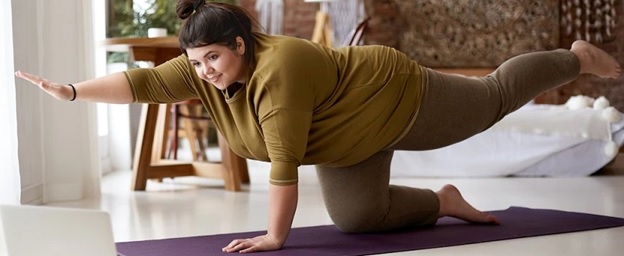First and foremost, if you are significantly overweight, ask your doctor or health care provider to see if it is OK for you to do overweight workouts.
How Long should you Workout
Indeed, the U.S. Department of Health and Human Services recommends that most healthy adults get at least 150 minutes of moderate aerobic exercise a week. Also, they recommend strength training at least two days a week. In addition, they recommend some flexibility and stretching workouts.
Incidentally, the weekly 150 minutes can be composed of five sessions a week, with each session being 30 minutes long. Furthermore, you’ll still experience the benefits of your workouts if you choose to break those 30 minutes into two 15-minute sessions or three 10-minute sessions throughout the course of the day.
Also, when you first begin, don’t allow yourself to get hung up on the clock. Instead, focus on picking a workout that you enjoy and that can fit into your schedule at least three to five days a week.
In addition, if you are just starting out begin slowly and most of all avoid overdoing it. In the beginning, it doesn’t even matter if your workouts are so short that they aren’t contributing significantly to burning calories. In fact, all that matters is that you are doing what you are capable of. That’s how to begin preparing your body for longer workout sessions.
Lastly, to increase your chances of successfully sticking to your workouts, try to schedule them for the same time each day. For example, schedule your workouts in the morning, afternoon, or right after work. Indeed, the goal is to repeat this behavior until it becomes a habit.
Kind of Workouts
Move your body
So, if you are overweight, focus on activities that put minimal stress on your joints. Start by getting used to moving your body in small ways. In fact, if you are obese, moving your body can be physically challenging. So, start by doing small movements every chance you get.
For example, instead of using the remote, walk across the room to change the TV channel. As another example, put on ankle weights and just move your feet back and forth. Or lift your arms over your head and reach towards the ceiling.
All these movements can help build and strengthen muscles. And they are a good way to start.
Walking
As you become stronger, and if it is convenient, you can start with water exercises. In fact, water exercises provide more support for your body. However, if regularly going to a swimming pool becomes a chore or inconvenient, you can start with walking.
In fact, you can start by walking for just 10 or 15 minutes each day. And as you build up your strength, gradually add time so that you work towards one full 30-minute session.
In the beginning, don’t worry about how fast or slow you are walking. Just try to be consistent every time you walk. Over time, as you become more fit, you can see that you can go faster and longer. Incidentally, obese clients seeking weight loss are encouraged to progressively strive to accumulate 10,000 steps per day, including at least 10 minutes of walking at a moderate intensity. By the way, researchers have found that for adults between the ages of 21 to 40, a moderate intensity walk is achieved at a pace of 100 steps per minute.
Now, a lot of overweight people have balance issues. So instead of walking on a street, a treadmill is a very predictable and safe place to walk in the comfort of your home.
Recumbent Stepper or Bike
Incidentally, if you have back pain, joint problems, or simply need more support, use a recumbent stepper or bike. Furthermore, recumbent steppers or bikes are less stressful on the lower spine, a common problem for the overweight or the obese.
Strength Training
Next, strength training can increase the range of motion in your joints. Also, when you build muscles, you boost your metabolic rate when your body is at rest. Furthermore, many weight training workouts can be down while sitting.
So, you can start lifting weights at home. However, going to a gym and/or hiring a trainer may be especially helpful to learn simple exercises and techniques. Also, the trainer can show you how to keep your form in good shape and avoid injuries.
Stretching
Next, stretching is important to reduce sore newly worked muscles. Also, stretching prevents injuries. Because at first, the muscles are extremely tight, stretching can be difficult. So, start slowly and gently work up to your goal. Eventually, the muscles will start stretching.
TIPS
- Finally, listed below are some tips that may help you.
- First, even if obesity runs in the family, physical activity and the right diet helps you to lose weight.
- Second, it will take time to lose weight, so temper your expectations and work for the long-haul. Most of all, avoid looking at your scale. And, if you must, do it very infrequently. Furthermore, develop patience and let the body do its thing.
- Third, force yourself to exercise regularly at about the same time and for the same amount of time.
- Fourth, you can work out either seated or standing.
- Fifth, instead of just one specific workout, do a variety of workouts so different parts of your body get worked out.
- Next, working out becomes easier the more you do it.
- Also, work out wherever you are most comfortable. That could be your home, the gym or the outdoors.
- In addition, some may find working out with a friend helps you to push on. However, remember each person is different. So, don’t compare your progress with your friend’s.
- Furthermore, try different workouts and home in on those which you find most comfortable.
- Finally, research shows that the overweight, adhere better to a workout when the workout is not supervised and chosen by you.

